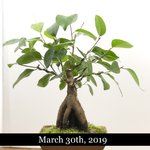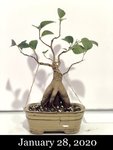DonovanC
Chumono
F. microcarpa vs. F. retusa
So for quite a while now, I’ve occasionally pondered the difference between the two species. Many sources definitely use the two names interchangeably. And, I’ve not been able to find any good sources that really help in identifying and distinguishing the two species. So, does anyone have any good resources as far as Ficus taxonomy? I’m looking for scientific, taxonomic information.
Lastly, this is one that I’ve been calling microcarpa for the past year, but I’d love a positive ID - along with identifying information. It wasn’t grafted. When I purchased it, it appeared to have just been chopped. First photo is when I first got it, second is current.
Thanks!

So for quite a while now, I’ve occasionally pondered the difference between the two species. Many sources definitely use the two names interchangeably. And, I’ve not been able to find any good sources that really help in identifying and distinguishing the two species. So, does anyone have any good resources as far as Ficus taxonomy? I’m looking for scientific, taxonomic information.
Lastly, this is one that I’ve been calling microcarpa for the past year, but I’d love a positive ID - along with identifying information. It wasn’t grafted. When I purchased it, it appeared to have just been chopped. First photo is when I first got it, second is current.
Thanks!




